Periodontal diseases affect millions of people. These gum diseases start very early in life and are responsible for more tooth loss than all other causes combined. In the early stages, periodontal diseases are silent infections. This means that you will typically not know there is a problem until the disease is quite advanced. If you have any concerns about gum health, contact our office in Tampa, Florida, today to schedule your consultation.
What are periodontal diseases?
Who gets them?
How do they start?
Can you prevent them?
Can they be successfully treated once they start?
- Introduction
- Normal Gums
- Infected Gums
- Stages of Periodontal Diseases
- Gingivitis
- Periodontitis
- Plaque is the primary cause of Periodontal Infection
- Plaque Become Calculus
- Plaque Toxins Destroy Bone
- Natural Resistance Or Susceptibility To Periodontal Diseases
- The Periodontal Examination
- The Specialist
- Conclusion Of Part I
Part - II
- Normal And Healthy
- Stage One Of Gum Disease: Gingivitis
- Stage Two: Early Periodontist (Early Bone Loss)
- Stage Three: Moderate Periodontitis (Moderate Bone Loss)
- Stage Four:Severe Periodontitis (Advanced Bone Loss)
- Conclusion of Part II
Part - III
- Personal Oral Hygiene
- Professional Removal of Plaque and Calculus
- Professional Assessment of the "Bite"
- Professional Maintenance
- Conclusion of Part III
PART - I
Gives you general information about periodontal diseases: the signs of gum disease, the causes, and what you and your dentist can do to prevent periodontal diseases or arrest disease that has already started.
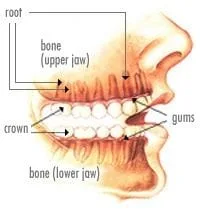
Each tooth consists of two parts: the crown and the root(s).
Normally, only the crown is visible in the mouth. The roots anchor the tooth in the bone.
The gums are a specialized type of skin that surrounds the teeth and covers the bone holding the teeth.
Each front tooth has one root. Back teeth have one, two, or three roots.
back to top
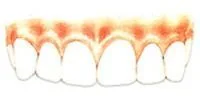
This diagram shows the gums of a person who has a light complexion. People with dark skin normally have gums that are quite a bit darker.
back to top

Sometimes, gums that are infected look like this.
But many people who have gum infections, even in a advanced stages, may have gums that look essentially normal. That is why only a thorough examination by a dental professional can detect most gum problems.
back to top
Stages of Periodontal Diseases
Periodontal diseases can be divided into two stages:
- Gingivitis
- Periodontitis
back to top
Gingivitis
Gingivitis is a superficial infection that is limited to the gum tissue and does not yet affect the underlying bone. The gums may look normal, but may have some of the following signs:
- Redness and puffiness
- Bleeding when brushed
- Bad odor
back to top
Periodontitis
When the infection spreads from the gum to the underlying bone, it is termed periodontitis ( once called pyorrhea). In this stage, bone that supports the teeth is lost. There are several types of periodontitis, some more aggressive than others. If periodontitis is untreated, tooth loss can occur.
In some cases the gums appear red and swollen, and other signs may warn you of trouble:
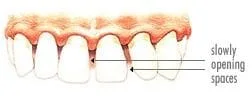
- Spaces begin to appear between the teeth. This can be a sign of an advanced problem.
- Loosening of one or more of the teeth. This is almost always a sign of severe bone loss.

- Receding gums. Periodontal diseases may cause gums to shrink away from the crown and expose some of the root. This makes the teeth look longer. Gum recession is not normal at any age.
- Vague aching, itching, or other discomfort of the gums.
Periodontal diseases are almost always painless, and only rarely do you notice changes, especially in the early stages. Therefore you probably will not notice gum puffiness or pay attention to occasional bleeding when you brush. Or you may think that the longer look of your teeth is normal for your age. But the fact is, four out of five teenagers and adults have a periodontal disease, and most don't know it. That is why people lose more teeth from periodontal diseases than from all other reasons combined.
But the good news is that most periodontal disease can be prevented or, if already started, can be treated. This is particularly true if action is taken in the early stages of gum disease.
Plaque is the Primary Cause of Periodontal Infections
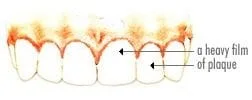
In very large amounts, plaque can be seen or can be felt with the tongue as a fuzzy, unclean coating on the teeth.
The bacteria of plaque produce toxins (poisons) that damage the gums and underlying bone.
back to top
Plaque Become Calculus
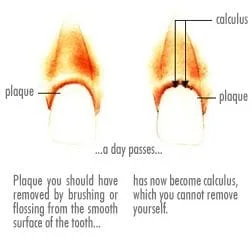
It takes only a little more than a day for any plaque left on your teeth to turn into calculus.
You can't remove calculus yourself. It clings to the teeth with such force that only a dentist or hygienist can remove it.
It is possible to see calculus that forms above the gums. It appears as a brownish or black deposit around the necks of the teeth. However, it is the hidden calculus under the gums that does the most harm.
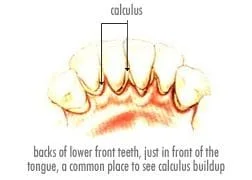
Thus, all calculus will always have plaque embedded on its surface. And all plaque is capable of starting or worsening periodontal diseases.
It is very important that you never let calculus get a start. Floss and brush away plaque every day. Never let plaque remain long enough to become calculus.
- You can remove sticky plaque from your teeth.
- You can't safely remove calculus or the plaque that forms on the surface of calculus, especially below the gums.
back to top
Plaque Toxins Destroy Bone
The toxins produced by the bacteria in plaque not only infects the gums, but also destroy the underlying bone that supports the teeth.
As the gum infection continues, so does the bone destruction, usually without any gum disease symptoms, especially in the early stages of the disease.
When sufficient bone has been lost, the tooth loosens. When a tooth loosens, the destruction of bone around it may accelerate.
Finally, when deprived of most of the supporting bone, the tooth becomes so loose that it either falls out or must be removed.
back to top

Disease has caused severe recession of the gums and has destroyed half the bone holding these teeth. These teeth are loose.
Natural Resistance or Susceptibility to Periodontal Diseases
Very few people are totally resistant to periodontal diseases. Most are quite susceptible.
However, most people have a varying resistance to these diseases at different times in their lives. For examples, a person's resistance may be normal for years. Then resistance temporarily diminishes and periodontal disease appears, or disease that was under control flares up.
While periodontal diseases cannot be cured, in most cases you and your dentist together can slow down or arrest the disease. For the majority of people, tooth loss can be prevented.
back to top
The Periodontal Examination
You cannot accurately diagnose periodontal diseases yourself:
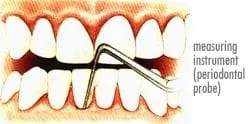
- They most often start between back teeth where you can't see them.
- They will almost always be painless.
- There is usually no "pink toothbrush" (bleeding) to warn you.
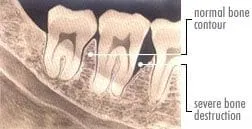
The dentist or dental hygienist will gently examine for hidden areas of disease (pockets).
Your dentist will also need a complete set of x-rays to help in diagnosis and treatment planning.
back to top
The Specialist
If you have a periodontal problem that does not respond to routine care, or if you have advanced disease, you may need to see a periodontist.
A periodontist is a specialist in the care of the gums and supporting bone. He has years of extra schooling and experience that permit him to use special techniques to treat more difficult or more advanced periodontal problems.
back to top
- Periodontal disease are infections.
- The primary cause of these infections is plaque, a sticky colony of living bacteria. If left on the teeth, plaque forms calculus (tartar), which you cannot safely remove at home.
- Million of people have some type of periodontal disease, but most do not realize they have the problem.
- There are two stages of periodontal diseases:
Gingivitis, an infection of the gum.
Periodontitis (pyorrhea), an infection that involves the supporting bone. - See your dentist on a regular basis, even if you think nothing is wrong. Only a professional can diagnose periodontal diseases in their earliest stages, when they are the easiest- and least costly-to treat. Loss of all your teeth from periodontal diseases is not inevitable. You and your dentist, working together, can see to that.
back to top
PART - II
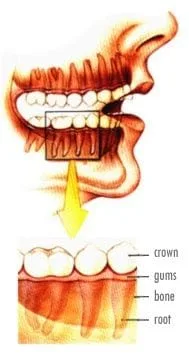
PART II Will tell you, step by step, how periodontal diseases cause the loss of a tooth.
First let's look at some important relationship between the teeth, the gums, and the bone.
The teeth within the square opposite will appear in the diagrams that follow.
This drawing shows what is beneath the surface.
Many thousands of fibers, called periodontal fibers, go from their origins on the roots of the teeth into the gums or the surrounding bone.
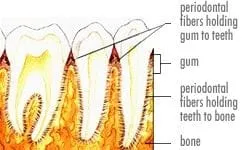
The great mass of fibers that go from the roots into the bone attach the teeth to the bone.
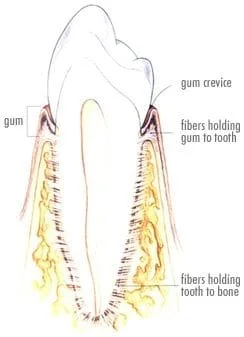
Some people mistakenly believe that teeth are " in the gums." Not so. Teeth are in bone. The gums are a protective covering over this bone. In a healthy mouth, the gums hug the teeth like tight collars to prevent bacteria and food debris from invading the bone. Simply put, the gums protect the bone, and the bone holds the teeth.
This isolated tooth is enlarged nine times the normal size
The fibers going from the root into the gum pull the gum tightly against the crown. There is a small crevice between the gum and tooth that you don't see when you look in your mouth. This area, where the gum lies against the crown, has been called the gum crevice (or sulcus).
The depth of this crevice is of major importance.
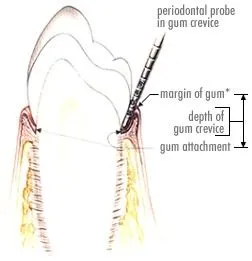
* The margin of the gum is its upper edge.
The markings on the periodontal probe are 1 mm apart. (An actual millimeter is the distance between these two lines .)
Normal crevices measures 1 to 3 mm deep. The crevice in this drawing is 2 mm deep.
The next few sections will help you to understand how periodontal diseases actually progress.
Keep in mind as you read that you and your dentist can prevent periodontal diseases. Even if disease has started, you and your dentist together can treat it. Most people do not have to lose their teeth.
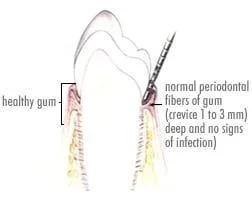
Periodontal fibers hold the normal gum tightly against the tooth.
back to top
Stage One of Disease: Gingivitis
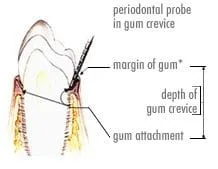
Professional gum disease treatment and good personal home care at this earliest stage can usually arrest the disease. The gums restore themselves to full health, with no permanent damage.
back to top
Stage Two: Early Periodontist (Early Bone Loss)
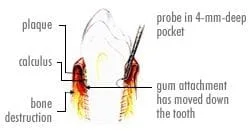
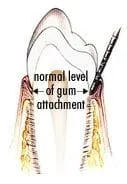
A crevice more than 3 mm deep is considered a pocket. Pockets are very hard to keep clean. They are impossible to keep clean once calculus has formed within them. The toxins from the plaque in the pocket shown opposite have also destroyed some adjacent bone.
Professional gum disease treatment plus good home care can slow or stop the progress of disease at this stage.
back to top
Stage Three: Moderate Periodontitis (Moderate Bone Loss)
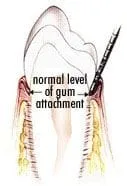
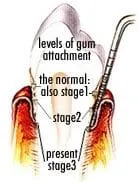
back to top
Stage Four: Severe Periodontitis (Advanced Bone Loss)
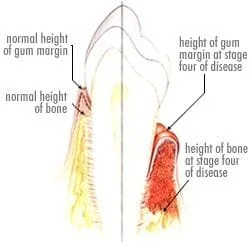
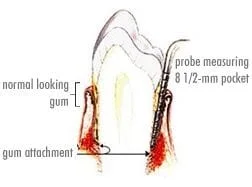
Even in this advanced stage of periodontal disease, professional treatment and proper home care usually help considerably. In some cases it is possible to replace lost bone by using advanced surgical techniques.
Adjacent diagram shows how much bone loss and gum recession have taken place at STAGE FOUR.
back to top
CONCLUSION OF PART II
Plaque bacteria produce the toxins that cause the infections of periodontal diseases.
If untreated, periodontal diseases often cause bone loss.
If periodontal disease destroys enough of the bone supporting a tooth, the tooth will be lost.
Periodontal diseases need not happen:
- Brush and floss properly to remove all the plaque.
- Get regular periodontal examinations, including periodontal probings.
- Follow through on any necessary treatment.
back to top
PART - III
PART III will explain how your dental professional, with your cooperation, can treat periodontal diseases to reduce the chance of tooth loss.
- Personal Oral Hygiene
- Professional removal of Plaque and Calculus
- Professional Assessment of the "bite"
- Professional Maintenance
back to top
Personal Oral Hygiene
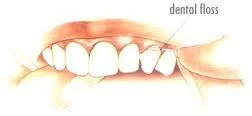
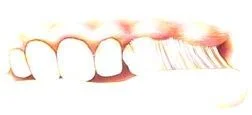
Dental floss removes the plaque from between the teeth, where the toothbrush can't reach.
If you brush but don't floss, you are doing only half the job.
It is important to brush correctly every day.
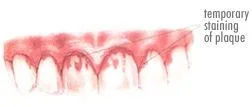
Drugstores sell inexpensive disclosing tablets that contain a harmless vegetable dye. You should occasionally dissolve one in your mouth after flossing and brushing. It will temporarily stain any plaque you have missed, showing you areas where you must take a special effort to clean more thoroughly.
back to top
Professional Removal Of Plaque And Calculus
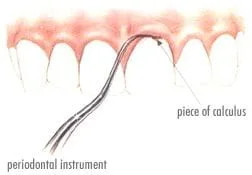
Your dentist will check any restorations for correct shape and fit. Fillings and crowns that no longer fit will trap bacteria and food debris. This can cause severe periodontal problems. Have such fillings or crowns repaired or replaced.
back to top
Professional Assessment of the "Bite"
A balanced bite (one where the teeth meet evenly during chewing) is important for many reason, but it can be crucial when periodontal inflammation is being treated. Too much force on a tooth with periodontal disease can cause bone loss to accelerate.
Your dentist may inspect the way your upper and lower teeth come together (the "bite") to see if the force of chewing are evenly distributed among all the teeth. If you are chewing on some teeth harder than on others, he may gently reshape the biting surface of these teeth until they meet evenly.
back to top
Professional Maintenance
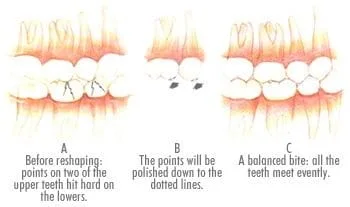
It is very common for periodontitis to recur. Patients should have regular checkups to catch recurrence early, before silent damage occurs. Many patients with periodontitis will have to get checkups, usually accompanied by a professional tooth cleaning, every 3 months. These checkups, which catch disease in its early stages, will prevent suffering, save money, and provide the best chance against tooth loss.
back to top
CONCLUSION OF PART III
Prevention and treatment of periodontal diseases involves the combined efforts of you, your dentist (or periodontal specialist), and the personnel who clean your teeth.
- They will remove plaque and calculus that may have formed despite your best efforts at home care.
- They will check for factors that contribute to periodontitis, such as defective fillings or crowns or a bad bite.
- They will check on your brushing and flossing techniques.
- They will provide regular maintenance care after initial gum disease treatment of periodontitis.
- But professional care is only half the battle in preventing or curing periodontal diseases. The essential other half depends on you to brush and floss every day.
- The good news is, with care, your teeth can last a lifetime.
back to top

